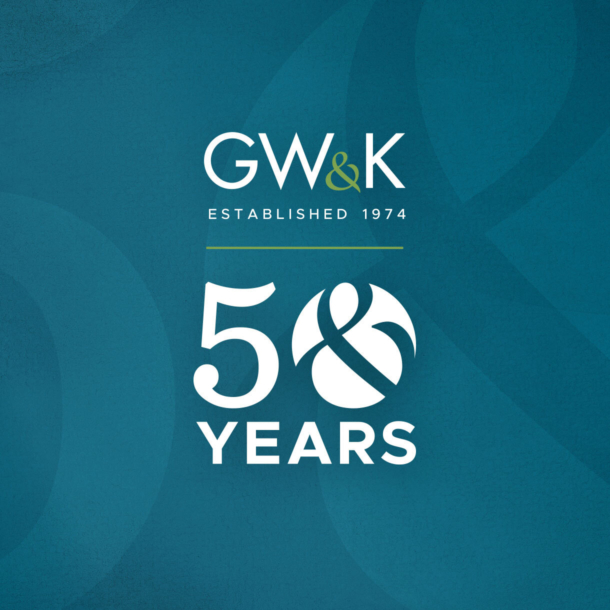
Read from Wealth Strategist, Melissa Jacoby on a few options that may minimize or prevent the need for probate.
Read Article
Global Strategist Bill Sterling shares his latest research on navigating the concentrated US stock market.
Read Article
Hear from employees about what makes GW&K such a special firm and read about some of the milestones on our journey to 50 years of active management.
Read ArticleWe use cookies to improve your experience on our website. To accept cookies click Accept & Close, or continue browsing as normal. For more information or to learn how to opt out of cookies, please see our cookie policy.
Accept and CloseGW&K's CIO and Portfolio Managers share their insights and opinions on the economy and market each quarter.
Firm-wide
Read from Wealth Strategist, Melissa Jacoby on a few options that may minimize or prevent the need for probate.
Read ArticleMunicipal Bond
GW&K’s Director of Municipal Research, Sheila May, writes about the state of California's budget and why we remain comfortable with the state’s credit profile.
Read Article
Listen: GW&K Market Insights with Harold Kotler & Bill Sterling
We invite you to listen to our quarterly conversation with Harold Kotler, Bill Sterling, and moderator Dan Fasciano as they review events from the fourth quarter of 2023 and discuss:
We are available to answer your questions and address any concerns you may have so please do not hesitate to contact us.
GW&K Market Insights 4Q23 (17:31)
Download the MP3
Dan Fasciano: Welcome to the Fourth Quarter Client Conference call for GW&K Investment Management. This call represents the views and opinions of GW&K Investment Management and does not constitute investment advice, nor should it be considered predictive of any future market performance.
My name is Dan Fasciano, Director of Private Wealth here at GW&K. Joining me on today’s call is Harold Kotler, GW&K’s Chairman and Chief Investment Officer, as well as Bill Sterling, our firm’s global strategist.
Harold, we just close the books on a year where developed market equities returned 15 to 30% and bond returns were north of 4%. Are there any takeaways you have from the year and what themes are you carrying into 2024?
Harold Kotler: Well, it was a remarkable ending to a year that halfway through, one would not have believed it would be so successful — or that the Fed might be able to develop a soft landing in moderating this inflation fear. I think the markets started to celebrate. It’s a relief rally that maybe it’s all clear. And I think as you look into 2024, I think you absolutely have to be believing that’s the takeaway, that rates will decline. When and how much is yet to be determined — and probably not really very relevant.
The fact is the rate rises are behind us, rate declines are ahead of us, a moderation of inflation is continuing, and, I hate to sound optimistic, but it sounds like it’s good times and I think we should celebrate. And that’s what the market has done, and I think will continue to do.
Dan Fasciano: You don’t have to hate being optimistic. You do a good job of it. Bill, Harold just took us there, so I want you to weigh in from a macro perspective. You know, we come into this year with investor sentiment squarely behind the notion of a Fed pivot. Fed fund futures were pricing in six cuts by this year’s end. What do you make of all of that? And what’s your thinking as it relates to growth and inflation for the year? I mean, are there any themes that you’re particularly watching for?
Bill Sterling: You know, I think the big debate in the markets is whether investors might be over their ski tips expecting too much easing. You know, I think the Fed in December, based on pretty good news about soft-landing growth data and very good inflation data, guided market participants towards three cuts this year.
And I think personally three or four is the most likely outcome, which should be great, as Harold indicated. I think the reason the market thinks it could be five or six cuts is that many economists still see an elevated chance of a recession based on the lagged effects of all the monetary tightening that has been put in place so far. If a recession were to occur, that could require seven, eight, or even nine cuts. It would probably be negative for earnings as well.
So I think one theme is to be careful what you wish for. I think a scenario of three or four cuts would be more consistent with a soft landing for the economy and probably better for equity markets as well. But the Fed fund futures that you referred to are basically a weighted average of the soft-landing scenario and also potentially some of those weaker recession scenarios. And only time will tell whether the Fed needs to be more aggressive than three or four cuts.
Overall, my impression is the Fed can’t believe its luck that a soft landing is unfolding so well and is focused on not messing it up by either, you know, declaring victory over inflation too soon or by waiting too long to start cutting. And that’s, you know, a challenging job for them.
Harold Kotler: But I also think Bill, to your point, that we have to worry about something, right? I mean, the job, it can’t be that easy. So, the markets will go up and down with fear of inflation reemerging or too fast or too slow. So that’s going to be the static all year. But for investors, I think to clear the air of static, it’s in the right direction for all of us to participate in a healthier economy, even if we go into a slight recession defined by two quarters in a row of negative GDP. It really will be so modest that it will be a nonevent. Maybe another Y2k.
Dan Fasciano: We’re going to have an event this year, Harold, so I’m going to give you a chance to give us something to worry about. We just discovered that former President Donald Trump won the Republican New Hampshire primary, so it’s looking increasingly like a Biden-Trump rematch in November. What’s your sense of what role the election might play in the economy and in the markets as this year unfolds?
Harold Kotler: The funny thing about these two people is that their policies were very similar, and they expanded the deficit. They provided, in my mind, much too much liquidity in the system — that’s why the Fed had to be so resourceful and increase rates so quickly. Their economic policies haven’t been so different, and the US economy really is not that dependent on who’s president. On the edges, it has some impact and it’s impactful for people and policies at some level. But when you look at the macro economy, all that’s at work all the time — I would argue that doesn’t make any difference who wins the election. People will take issue with that because there’s other issues at stake. I’m not going to get into politics. But as it relates to the economy, I think it’s a nonevent.
Dan Fasciano: Well, Bill, I want to take it then squarely back to the economy and rates. You know, despite higher rates, US consumer behavior and sentiment have remained resilient. We saw that in the fourth quarter. Is it reasonable in your mind to think that the trend is going to remain in place? Or do you think that lagged effect that you referred to a bit ago will finally have a bite? And I guess the larger question is, has tighter monetary policy already worked its way through the system or not?
Bill Sterling: You know, they’re great questions, Dan. I guess personally, I’d be surprised if rates do not have some kind of bite. You know, for example, credit card interest rates have reached a pretty bracing level of 21.5%. And also, credit card debt has surged to $1 trillion, but personal interest payments have now crossed $500 billion. And many households have had to resort to credit cards since the personal savings rate has come off quite a bit from its highs during the pandemic, and is at a historically low level of 4.1%.
I think against that kind of backdrop, especially if the labor market slows, economists expect real growth in consumer spending to slow from what looks like turned out to be 3% real growth last year to something like closer to 1% this year. And that’s what would constitute a soft landing. And after that slowdown, then I think investors could be looking to the back half and into the following year for the benefits from that easing. But the idea that consumer spending is likely to slow, and that it’s going to react to the lagged effects of that monetary restraint, sounds about right to me.
Dan Fasciano: Thinking about the market specifically, Harold, let me get your sense of two market dynamics that are in front of us. One is: Rates are clearly in a higher range now than they’ve been since the pre-2008 global credit crisis. And the second item that comes to mind is US small cap stocks have lagged large caps for almost every time period. What do you make of both that range of higher rates, in small caps, lagging large caps, and more importantly, what should our clients be thinking about that?
Harold Kotler: That is an incredibly important question. I would say that, as I wrote in my quarterly letter, the human mind does adjust. And there was a time probably many of us can remember having a mortgage on the homes of 6% – 10%, and somehow we survived. Then, of course, it plummeted to zero. And now it’s back to 6% or 7%, probably on the way back to 5% or 6%. But incrementally, as it declines, psychology improves and people’s behavior changes. And I think we’re moving towards normalization. We’re not there. It will take time, given Covid and all these other issues. We’ll get there. At some point, the markets will find their own balance. And I think that’s what’s going to happen this year and next year.
As it relates to small cap, clearly the cash flow available by those large, very successful, high-tech companies has been remarkable. The amount of liquidity and availability to invest in new technologies is tremendous amongst those seven sisters that everybody talks about, and small cap has been left behind. Now, one has to believe that in this wonderful country, entrepreneurs are still doing what they should be doing and building businesses and doing it correctly. And sooner or later, they’ll be recognized in the marketplace. I don’t think it means one or the other. I think both sectors can do well. I think the high-tech companies with huge cash flows that make acquisitions any time they want and buy new technologies, are going to be overwhelmingly successful. I also think entrepreneurs still have a way to make money and they can make an effort to get a piece of the apple and succeed. And that’s what we’re investing in. The valuations are compelling, so it’s too tough to make a choice. I just think — I always say this and I really mean it: You have to be diversified. I wouldn’t walk away from one market or the other. I’d participate in them all and I think this year could be a very good year for everybody.
Dan Fasciano: That’s helpful. Bill, I want to turn to you on a theme that Harold just touched on, and that was these magnificent seven tech-oriented companies and their performance over the last year. You know, what do you make of the narrowness of the market, particularly over last year? And what would you say to our clients and investors about how to interpret that into 2024?
Bill Sterling: Well, Dan, I agree with Harold’s optimism and also his emphasis on diversification in navigating this kind of environment. To put some numbers on it, when you look at the dominance of the Magnificent Seven, they’re up about 115% now since the end of 2022. That makes sense because AI is truly a game-changing technology. And in comparison, the equally weighted S&P 500 Index and the Russell 2000 Small Cap Index are up only about 10% or 12%. What’s worth keeping in mind is, that bifurcation and stock performance — which is really the reflection of the narrowness of the market — has left also a very wide bifurcation or gap in valuations. If you look at the average forward P/E of the Magnificent Seven, it’s close to 45 times now, compared to less than 20 for the equally weighted S&P 500 and close to 15 times for the Russell 2000. The typical stock out there, outside the Magnificent Seven, is pretty attractively valued, as Harold indicated.
I’d also note that the Russell 2000 is still off its all-time high by about 20%, while the S&P 500 Cap Weighted Index and growth stocks are at all-time highs. So personally, I think there’s better than even chances that as the market advance continues, it’s going to broaden out to include small caps and call it the other 493 stocks outside of the Magnificent Seven that generally have very attractive valuations, catch-up potential, and are run by entrepreneurs who want to make things work.
Dan Fasciano: When I listen to the two of you, you know, we use the word diversification. A lot of times that means stocks, bonds, make sure you have some international. But there’s also an element here of making sure you don’t get too offsides in terms of, you know, sectors or, you really almost want someone monitoring a whole bunch of dynamics around diversification. It’s not just stocks and bonds. As you say, Bill, those other 490 companies — you want to make sure that you’re allocating thoughtfully.
I guess with all of that in mind, Harold, I’m going to give you the biggest challenge of the call. And it’s my closing question. What indicators or events are you watching most closely in this first quarter of the year?
Harold Kotler: Can I step back and remind people that it’s been four years since we got hit with Covid? Four years. That’s disruption. I’ve been in the business almost 60 years, and never — but for Vietnam — nothing was as disruptive as Covid. And look where we are today. I go back to the private sector, and entrepreneurship, and investing, and smart people trying to recalibrate how they run businesses — that’s what it’s all about. Anybody who sits on their laurels is yesterday’s hero and today’s fool. You have to always be thinking about the opportunities that exist. That’s what I love about this business. And that’s exactly what you are talking about. It’s our job to be thinking about how best to invest without being cocky, without being that sure, but to diversify in areas that we think will be okay — and some will be fabulous, and some will be okay. But it’s okay that some are okay because we don’t know now which are the ones that will be the great winners.
When I look at 2024 and beyond, and think about where we’ve come from, where we are — and yeah, and the economy will slow, and things will have to recalibrate again and again and again. But the system works. And if you want to stay in money market funds and see your cash go from 5% to 4% to 3% to 2%, you can do that. And in the end, you’ll have to eat cereal in retirement. Or you can invest in this great, wonderful experiment called entrepreneurship in America and participate. And I just think it’s a gift that we’ve been given to have all our energy and focus and creativity on how to be the best we can be.
Dan Fasciano: There’s a lot of great marketing and life advice inside of that Harold, thank you. You know, Harold, Bill, I want to thank both of you, as always, for sharing your thoughts. Should anyone listening have a follow up question or two, please feel free to get in touch with your GW&K advisor. And to all of our clients and friends, enjoy the remainder of your winter months. We look forward to connecting again in April. Thank you.
Disclosures
This represents the views and opinions of GW&K Investment Management. It does not constitute investment advice or an offer or solicitation to purchase or sell any security and is subject to change at any time due to changes in market or economic conditions. The comments should not be construed as a recommendation of individual holdings or market sectors, but as an illustration of broader themes.